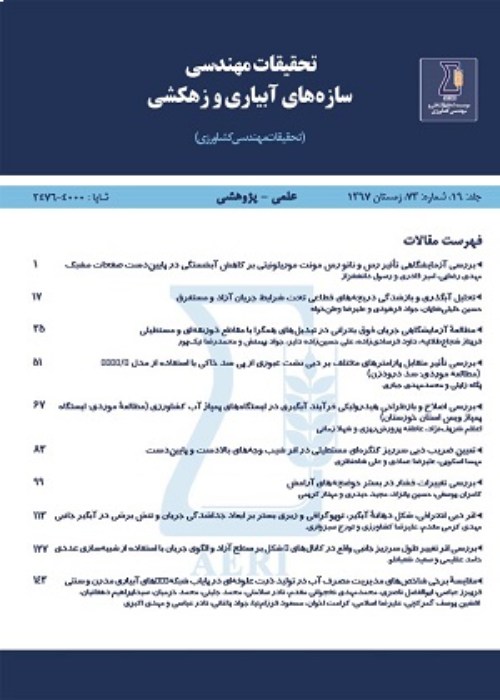Feasibility of Applying the Concept of Index Velocity in Estimating Discharge in Compound Channels
Determining the discharge in rivers using the cross-sectional area-velocity method, especially under flood conditions, is associated with serious challenges. Due to advances in measurement techniques, many researchers have strongly suggested the use of non-contact methods. The non-contact method that use surface velocity radar to determine the discharge are becoming more and more popular especially in flood conditions. This method is to use the concept of index velocity based on the generalization of surface velocity to mean velocity and discharge. Also index-velocity method was used for discharge monitoring or recording at streamflow- gaging stations with flow reversals, backwater effects, hysteresis effects and channel-roughness changes that the use of conventional "stage-discharge rating" method impractical or impossible. During floods, natural rivers appear in the form of a compound cross-section in their middle and end sections. Due to momentum exchange between main channel and flood plains, the flow hydraulic in compound channels is complicate. Most studies in index-velocity method are focused on prediction of the discharge in simple channels. Due to the hydraulic difference between the flow of simple and compound cross-sections, the velocity index (ratio of surface velocity to average velocity) for compound channels is still unknown.
The purpose of this study is how to apply the index velocity method in flood conditions (compound sections) and actually determine the optimal velocity index in compound sections and the highest percentage of its location in the width of the compound section. Also, by performing dimensional analysis, the influence of relative roughness parameters, Froude number, relative depth and relative width on the velocity index in compound channels was investigated. In order to build a laboratory compound channel, a channel with a rectangular cross-section with a width and height of 60 cm with a metal frame and glass walls was used. The height of the flood plain in all tests is constant and equal to 7 cm and three different widths of the flood plain 40, 45 and 50 cm in the smooth state and also one state of the flood plain with a width of 40 cm with metal mesh in compound form was made. Velocity distribution measurements were made in the compound channel, in the main channel and floodplain at 7 or 8 transverse points. In the present study, the velocity index in compound channels at a fixed bed slope of 0.1% and for the relative depth of the main section is 4.2-6.12 relative roughness 0.0003-0.0031 and Froude number 0.14-0.79 has been studied.
By examining the velocity index values across the compound cross-section it was found that the range of average of the velocity index in the width of the compound channels is 0.76-0.98 and with 63% relative frequency is in the range of 0.87-0.93. By fitting between all surface velocity and average velocity data in the entire compound cross-section, it was determined that the optimal value of the velocity index (with R2=0.95) for compound channels is 0.88 with value of absolute relative error of about 0.01-10.06% and an average relative error of 3.3%. The results showed that the increase in the relative roughness and Froude number of the approaching flow and the decrease in the relative depth in the floodplain cause a decrease in the velocity index. The relative error values of discharge estimation showed that in flood conditions (overbank), the velocity index value is different from the normal conditions (inbank) of the river and considering the same velocity index value for both normal and flood conditions will cause more error in the discharge estimation. By examining the location of the optimal value of the velocity index of 0.88 in the entire width of the compound section, it was determined that 71% of the density of points is located on the border of the compound channel and in the last quarter of the flood plain and the first half of the main section. Also, the velocity index is 0.92 in the main channel and 0.86 in flood plain, and if use them, a better estimate of the discharge in the compound channel is obtained. Analytical models of velocity distribution also showed that the velocity power law provides the best estimation of the velocity index than other models if the power index is chosen correctly.
The results showed that the use of the velocity index value of 0.88 for compound channels has an average relative error of about 3.3% in flow estimation. Therefore, by adjusting the default value, it is possible to improve the accuracy of flow estimation in flood conditions. In situations where the possibility of direct measurement in open channels (flood conditions) is not available, it is possible to use the cross section, the surface velocity at the border of flood plain and the main channel and the optimal velocity index of 0.88 can be accurately estimated.
- حق عضویت دریافتی صرف حمایت از نشریات عضو و نگهداری، تکمیل و توسعه مگیران میشود.
- پرداخت حق اشتراک و دانلود مقالات اجازه بازنشر آن در سایر رسانههای چاپی و دیجیتال را به کاربر نمیدهد.



